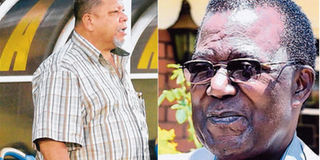Why Hans Poppe’s body took eight years to be buried

What you need to know:
- Dr James Makumbi was a physician at Mulago hospital in 1971 when Hans Poppe’s body was first brought there
- Through his binoculars, Lt Col Kisule recalls seeing Hans Poppe at a distance before the Armored Personnel Carrier he (Lt Kisule) was travelling in was hit
Kampala. Hans Poppe was the Assistant Commissioner of Police in charge of the present Kagera Region when Ugandan soldiers, under the command of Lt Col Abdul Kisule, entered the country to rescue their colleagues who had been captured by the Tanzanian police after wandering into foreign territory in 1971.
Through his binoculars, Lt Col Kisule recalls seeing Hans Poppe at a distance before the APC (Armored Personnel Carrier) he (Lt Kisule) was travelling in was hit. By the time he regained consciousness, he was on a hospital bed at Mulago.
In the battle that ensued, Hans Poppe was killed. What is not known was whether he was killed in the battle or captured alive and killed later.
Dr James Makumbi was a physician at Mulago hospital in 1971 when Poppe’s body was first brought there.
“When the body was first brought to us, it had gunshots in the chest. It was brought to the hospital by military personnel, demanding to be shown where the body can be preserved. They wanted a temporary preservation just like for any other dead body,” Dr Makumbi reveals several decades later in an interview with the Sunday Monitor.
The body was taken to the medical school for quick preservation. After the temporary preservation, the military people who had accompanied the body dressed it in the uniform it had come in and took it.
“The next thing we heard was that the body was being paraded at Kololo Airstrip, where Amin (Idd Amin -then President of Uganda) alleged that he was one of the Chinese mercenaries being used by Tanzania to invade Uganda.
I happened to have a sister-in-law married in Tanzania, and information reached us that this man was a Tanzanian.” Poppe’s father was a German and mother a Tanzanian.
After parading the body for three days, they sought ways of disposing it. Their intelligence officers knew that since bodies were being referred to Mulago medical school for preservation, it would be the ideal place to dump it. They dumped the body between Ward 16 and the Department of Anatomy, either in the dead of the night or very early in the morning.
At around 9am, the technician at the department rang, saying the body from the airstrip had been dumped there. He asked Dr Makumbi what they should do with it. Prof Stanley Tumwine was the head of the Anatomy department.
Dr Makumbi contacted him and discussed what they should do with the dead body. Bringing it to the hospital mortuary was the normal thing but they feared the public knowing the body was there.
They quickly discussed with Prof Tumwine and decided that they should actually preserve the body properly and keep it in the Anatomy department, hoping that one day, sanity would prevail and the relatives would come and pick it up.

Preserving the body for eight years
The Anatomy department has got a tank, which is the actual storage of bodies. The tank had a chain pulley with plates where bodies were placed. One body was put on the plate and the pulley was rolled down. What they did was to first remove all the bodies and put the one of Hans Poppe last and the other body plates were placed on top.
Normally, there are 15-20 bodies in the tank. Having put it there, they stayed hoping that nobody from the military would follow up. And indeed nobody came back to ask questions. The secret remained between Dr Makumbi, Prof Tumwine and the technician who controlled the tank.
Dr Makumbi and his colleagues were motivated to keep the body because of a number of things. First, they knew the deceased was not a Chinese mercenary as alleged. Secondly, they had received information that this man had been a police regional commander in Tanzania.
“The type of preservation we did is what we call permanent or long lasting treatment, which would keep the body for a long time. It is similar to the type given to the body of Sir Edward Mutesa II. We kept it there from 1971 to 1979. The tray in which the body was put was never brought up from the tank.” Within Mulago hospital, some people found out what exactly was going on and passed on the information to Tanzania.
The Tanzanian military intelligence found out what was going on and the revelation. One of their commanders only identified as Gen Lupogo had studied with Prof Tumwine at Makerere University. After the fall of Kampala, Prof Tumwine called Dr Makumbi to go and meet Gen Lupogo.
“The first meeting with the Tanzanian officials was at Mulago hospital soon after the fall of Kampala in 1979 and we showed Gen Lupogo the body of Hans Poppe,” Dr Makumbi says.
This was followed by another meeting at Nile Hotel during which they were informed they had been invited to go to Dar es Salaam. The three of them (Prof Tumwine, the technician and Dr Makumbi) were invited to go and meet the Tanzanian Military High Commander and narrated to them the whole story.
Apparently, two sons of the late Hans Poppe were part of the liberating forces of the Tanzanian People’s Defence Forces and they had heard about the body having been kept somewhere.”
Following the meeting in Tanzania, on May 23, 1979, the Uganda National Liberation Front (UNLF) government officially handed over the body to the Tanzanian government at a ceremony in Kampala presided over by Foreign Affairs Minister Otema Alimadi. His Tanzanian counterpart, Mr Benjamin Mkapa, who would years later become President, was in Uganda to receive the body.
“The three of us involved in the preservation of the body were invited for the burial in Iringa in Tanzania,” concludes Makumbi.




